Brian Carroll called me the other day, while I was traveling in Utah and asked for advice on his protein supplementation. When Brian calls you for help, you take it seriously; normally, people call Brian for help. So having just read the article, “Nocturnal Casein: Does a Case Exist?” in Muscular Development (MD)—the only mainstream bodybuilding magazine that I believe is worth reading right now—I thought I’d do a little research before answering him because the article brought up a few interesting points. Plus, this dovetails nicely into a new series I’m preparing that deals with a real-world plan for burning fat while gaining muscle that actually works; and protein intake is one of the most important factors.
Background
Competing to be the highest totaling power lifter of all time doesn’t make Brian’s goals any different from my own, or anyone else serious about their resistance training. We want to build muscle as rapidly as possible, or, at times, lose fat without sacrificing mass or strength.
I’m a bit obsessive and spent about a week researching this, much to Brian’s frustration. Although the MD article cited new and intriguing studies, it presented them out of context, leaving me perplexed, affirming things I know, but devoid of application. Had they presented the information in light of the last 30 years of research, they could have made some interesting recommendations.
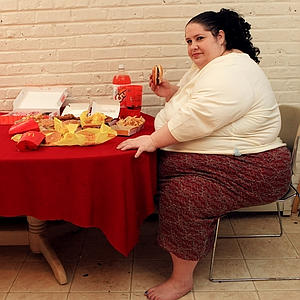 Excitement defined
Excitement definedI love doing new research, learning about the newest discoveries, and I have to be honest, what I learned this time excited me—and no run-of-the-mill excitement either—excited like a 600 lb woman eating her way through a mountain of Big Macs (true story; if you have the stomach for it, click here). For the first time, scientists are discovering several mechanisms of muscle growth, how to activate them, and how to sustain that growth indefinitely.
The old-school—well, current school—says proteins fall into two categories, slow-absorbing and fast-absorbing. Use slow absorbing, like casein, at night before falling asleep and use fast-absorbing, like whey isolate, after a workout for a spike of amino acids into the system. I’ve lived by this for years, which means I’ve been cheating myself of gains for years.
What we should be doing
Free amino acid (FAA) levels need to be kept high at all times: high when you get up, high through the day, high through your workout, high after your workout and on through until you go to bed and for as long as possible while you sleep. The extra-cellular concentration of essential amino acids, or the free amino acid (FAA) pool—along with other transcription factors—determines the growth rate of skeletal muscle. Maximum growth, or, more precisely, maximum protein anabolism occurs with sustained FAA levels. If you need to ingest a protein that absorbs super-fast because free amino acid levels have dropped, then you’re already behind the game.
Maximum anabolism is a key point. When skeletal muscle is in an anabolic state, the cellular machinery does everything possible to grow, which includes the prevention of proteolysis—the breakdown of muscle tissue. During a workout, when protein oxidation elevates, high FAA levels prevents muscle breakdown except during exercise. During resistance training, regardless of FAA levels, muscles do not grow, i.e. incorporate new protein into the cell. Muscle growth occurs before and after resistance training, but not during. Keeping FAA levels high during the workout blunts proteolysis, preventing the one-step-back scenario.
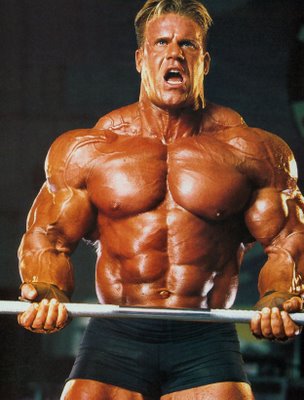 I’m sure Jay only got this huge and ripped because of Nitro-Tech protein.
I’m sure Jay only got this huge and ripped because of Nitro-Tech protein.Along with keeping FAA levels elevated, skeletal muscle also needs signals that tell them how much or how little of those FAA’s to incorporate into the cell. Insulin is one obvious positive signaler. Myostatin is a negative signaler. And one of the essential amino acids, leucine, is a positive signaler. All the essential amino acids and several non-essential amino acids, save leucine, fail to stimulate protein accretion and retention beyond normal. But leucine acts independently to speed muscle growth. The mechanism of action is too complex to discuss here, but the discovery is nothing short of amazing.
As mentioned above, insulin also helps stimulate muscle growth, as does lowering levels of myostatin. Insulin’s relatively easy to stimulate, but down-regulating myostatin is difficult and probably only achieved with resistance training (although, there’s mounting evidence that this occurs only for men…sorry ladies). But some old dogs do have new tricks and creatine’s one of them. Although the proof is scarce at the moment—scarce, but solid—creatine decreases myostatin levels, which may explain the accelerated rates of muscle growth when supplementing with creatine.
Putting it all together
The simple protocol, espoused in nearly every bodybuilding magazine, is easy to follow: casein throughout the day, whey after lifting and a lot of casein before bed. This prescription is okay, but far from optimal. Casein alone never raises FAA levels high enough, and whey is in and out leaving unwanted lulls. Also, new proteins are available—like whey hydrolysates and casein hydrolysates—that have unique and advantageous properties. Combining the different types into blends for different times is simple to do, even if it took looking through a few hundred research papers to confirm the methodology. This article is about protein and the subsequent amino acids but I’m going to add in carbs and creatine to the protocol where the impact is greatest.
You’re going to use one main blend most of the time consisting of whey isolate, whey hydrolysate, casein and casein hydrolysate. Upon waking, and every two to three hours thereafter, ingest 20 to 40 grams of this mixture along with 5 grams of added leucine with each meal. These are optimal amounts—under 20 grams produces less than optimal results and over 20 grams shows little advantage, although total saturation can occur at as high as 40 grams, and I don’t care how muscular a person is, their pancreas and liver are still the same size, still produce the same amount of enzymes and therefore can absorb only so much protein, i.e. 40 grams every couple or few hours is more than enough for anyone, and 20 is probably perfect. Make sure to get one of these shakes in about an hour before lifting along with 5 grams of creatine, and one right before bed sans the creatine. Don’t worry about getting up in the middle of the night to get a shake. Casein elevates amino acid levels for roughly eight hours and cortisol, levels of which naturally elevate through the night before falling in the morning, blunts the effects of high levels of FAA. Don’t sacrifice the sleep for an improbable and, at best, insignificant increase.
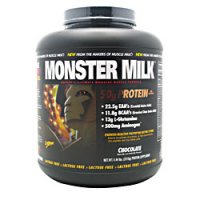
I’d hate to see the breast this stuff comes out of.
After lifting, ingest the second of your main blends. It’s 50% whey hydrolysate and 50% whey isolate. Make sure to ingest 40 grams of this blend within about 30 minutes to an hour of finishing the workout. Waiting longer won’t blunt gains much, as maximum growth occurs about 2 hours post-workout, but since whey needs an hour to peak amino acid levels, drinking it at the 30 minute to one hour mark is best. Despite twenty grams of pure hydrolysate being optimal, I recommend 40 grams of the blend to cover the spread. Make sure to add the 5 grams of leucine and another 5 grams of creatine along with 10 to 100 grams of glucose, depending on your carb tolerance and diet.
I suggest the blend of hydrolysate plus isolate over pure hydrolysate solely because pure hydrolysate tastes like…well, imagine burnt cheese mixed with burning rubber: that’s what it tastes like. If you can choke it down, more power to you, but there’s little you can do to kill the taste and life’s too short for unnecessary self-abuse, unless you’re into that kind of kinky thing. And if so, do I know the girl for you (watch the entire video below). Back to the horrible taste, the awful, vomit-inducing taste that leads me to believe that all of the commercial products that claim to use whey hydrolysate must be lying because their products taste damn good and I’ve tried adding everything in the world to differing mixtures of hydrolysate without success. A 50% blend—of two different hydrolysates—is the most tolerable I can find, no matter what I add to it or chase it with.
Where to get it
There are two companies who make creating these blends a breeze, ProteinFactory.com and TrueProtein.com. I use ProteinFactory.com for my needs, but I plan to take TrueProtein.com for a test drive soon, to compare and contrast. Both use US sources for their protein, so there’s no need to worry about China doping the protein with plastics that test positive for protein during assays (and yes, most of the major brands get their protein from China and, to my knowledge, none use an independent lab to check for plastic additives).
Blend one: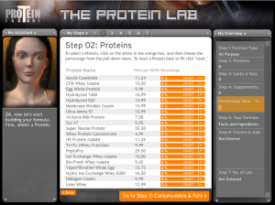 ProteinFactory.com
ProteinFactory.comAt ProteinFactory, select Custom Protein Lab from the top menu. In the popup, agree to their terms. On the next page, choose “All-Purpose” for the blend type (it gives the least amount of annoying suggestions, which, most of the time, are wrong). Select 35% CFM Whey Isolate, 10% Hydrolyzed 1400, 15% PeptoPro and 40% Heliogen Casein. This blend balances cost with growth potential as gathered from the research. Skip through the next few steps until reaching “Flavors and Additives”. Pick a flavor and sweetener (I suggest Splenda) and skip the additives. On the next step, choose the number of pounds to order and add to the cart for purchase.
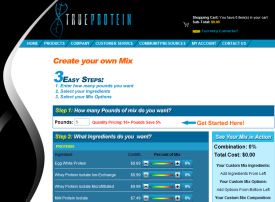 TrueProtein.com
TrueProtein.comAt TrueProtein, in the main navigation go Products » Formulas » Custom Solutions. Select 40% Micellar Casein, 10% Hydrolyzed Whey Protein High Grade, 15% Hydrolyzed Casein, and 35% Whey Protein Isolate (CFM). Here, the blend is cheaper, but doesn’t taste as good (swapping hydrolyzed casein for PeptoPro fixes the taste, but raises the price). Follow the rest of the steps accordingly.
Blend Two:Using the steps as above for Protein factory, create a blend of 40% Hydrolyzed 1400, 10% Hydrolyzed 520 and 50% Bio-Fresh Whey Isolate.
For TrueProtein, follow the steps above to create this mixture: 50% Whey Protein Isolate Microfiltrated, 40% Hydrolyzed Whey Protein High Grade and 10% Hydrolyzed Whey Isolate Ultra Grade.
Additives:ProteinFactory.com, unfortunately, does not sell pure leucine powder, where as TrueProtein.com does. But, on the other hand, ProteinFactory sells a rice-derived carb powder that’s nearly pure glucose, a product they call rilose and the best you can do from TrueProtein is maltodextrin. The two are somewhat equivalent. Both companies do sell creatine monohydrate. I’m annoyed that I can’t find one place that carries everything, but annoyance is no reason to forgo what I need.
Conclusion
With the science available right now, this is the optimal solution for muscle growth and even the prevention of muscle loss while adhering to a weight-reducing diet or the muscle loss associated with aging, which doesn’t have to be normal. And I don’t care what magic product is out there that combines hydrolyzed this and hydrolyzed that, enough sugar per serving to give a donkey a diabetic seizure and the newest creatine kre-alkabullshit, it cannot be better than what I recommend above (well, casein hydrolysates may hold some as-of-yet undiscovered benefits—I’ll keep you posted). Think about it: supplement companies tell stories about discovering magic compounds in their labs, compounds that a trillion-dollar pharmaceutical industry would kill to discover, companies that hire the most brilliant minds in the world; supplement companies hire advertisers and graphic designers. Do you think their products really work as advertised, or does their advertising work as promised?
(P.S. If enough people request via the comments a full and cited version of this post with more detail, I’m willing to write one up.)


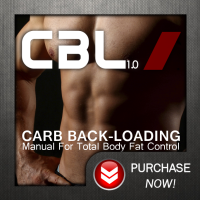





Recent Comments